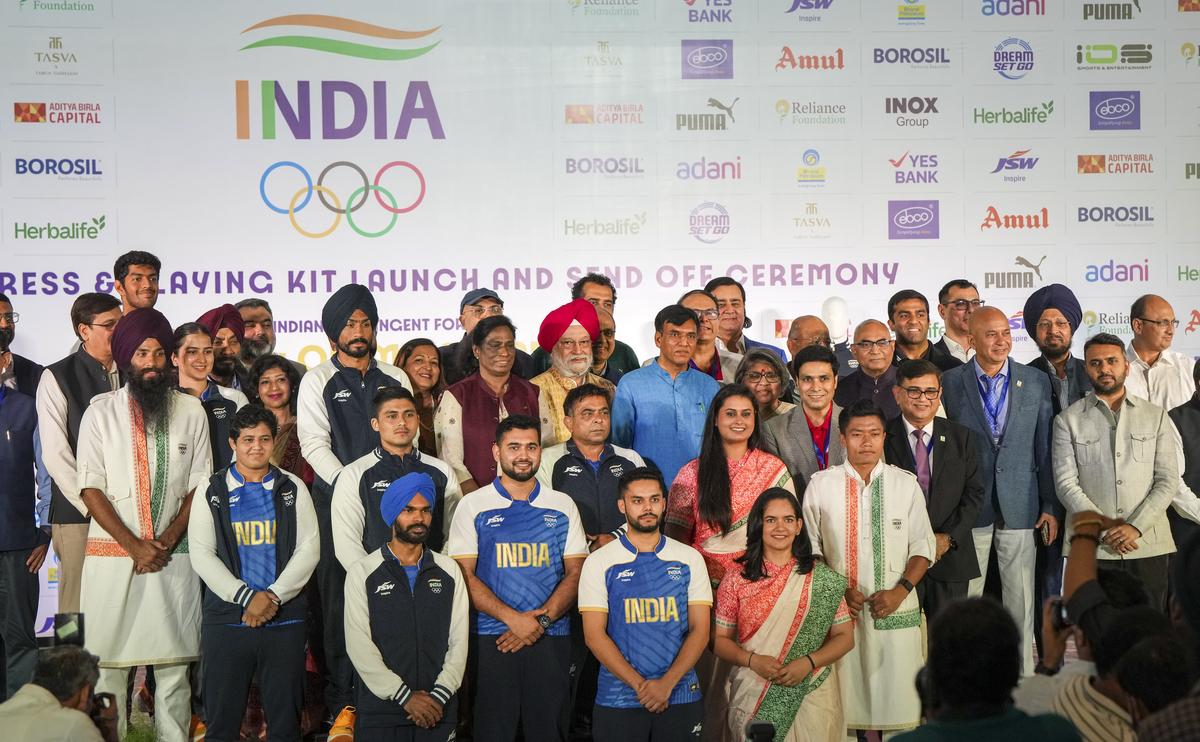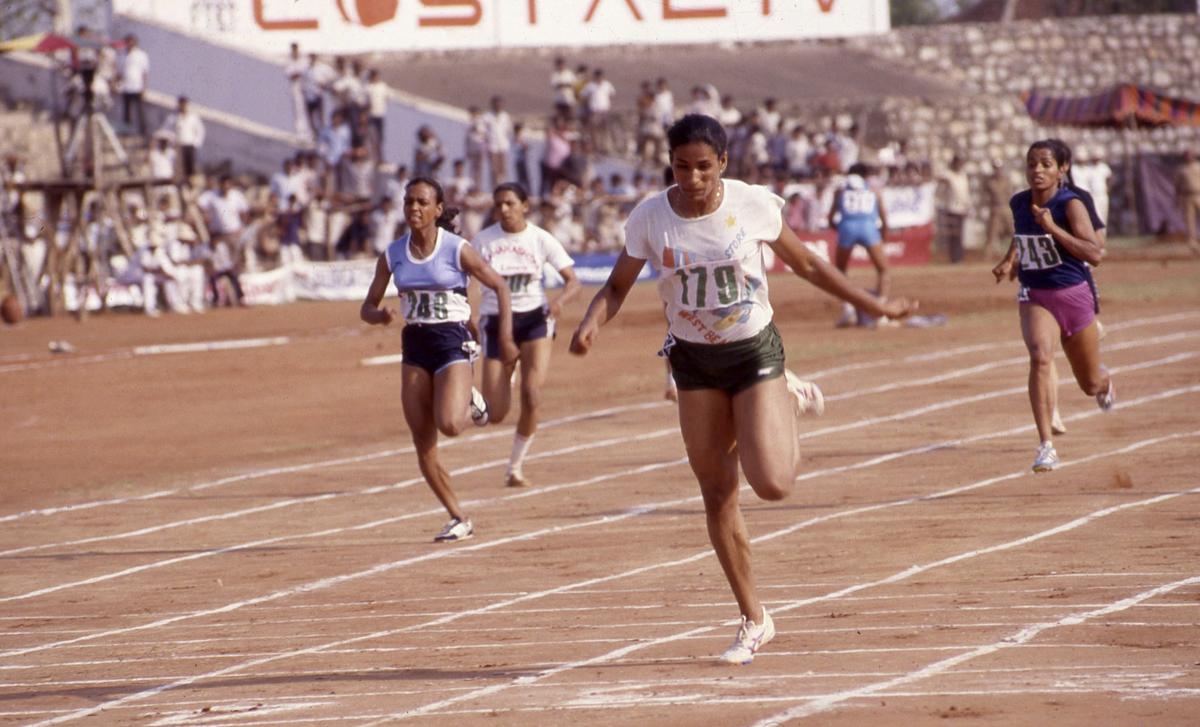IOA Chief P. T. Usha: Deeply committed to ensuring a safe and secure environment for all athletes, especially women
P. T. Usha is in a tearing hurry, as she was on the track, to bring in professionalism in the Indian sports administration at the Indian Olympic Association (IOA). Usha, winner of 23 medals, including 14 golds, at Asian track and field events, took over as the IOA’s first female president in December 2022.
Her tenure, however, has been far from easy, as she has been engaged in a bitter battle with her executive council regarding the appointment of professionals to the country’s Olympic body.
The former sprinter remains undeterred, and in a chat with Sportstar, she says she is committed to “making the IOA the true apex body for sports nationwide”.
Please share your views on the development of sprint over the years.
In 1980s, I ran 11.39 seconds [in 100m at Asian Championships]. Despite the lack of sports science and proper coaching back then, I clocked that time. How many athletes are doing the same time now with all the advanced facilities? One girl did set a national record, but she was caught doping and banned.
Why have we struggled to produce top-class hurdlers even though you showed the way much earlier?
You’re right. I was close to winning an Olympic medal because of my speed, not my hurdles clearance, which could have been better. The 400m hurdles is a very tough event — it is a tactical race with a lot of technical aspects. Nowadays, athletes choose events that offer a more significant participation platform. They prefer the 400m over the 400m hurdles.
Why do you think Indian sprint has not evolved? Why have we yet to see another sprinter emerge?
For sprinting, you need to be born with talent. While endurance can be pushed in other events, clocking times like 11.3, 11.2, or 11.1 seconds requires inborn talent. That’s the main reason.
Doping has been a big problem in Indian sports. Recently, India lost a boxing quota slot due to the whereabouts clause. How can we control doping in India, and how can we educate Indian athletes?
The whereabouts clause requires players to disclose their location; failure to do so will be interpreted as doping. We are making players aware of their responsibilities with guidance from the IOA and the Sports Authority of India. Players should realise they have a life beyond sports, but many are taking shortcuts, believing there is no sports science, something other countries are giving a lot of importance to.
We should treat doping as a criminal offence with exemplary punishment such as job loss or imprisonment. Some countries are taking bold steps, and we should too. When players win, we appreciate them along with their coach and physio. However, when a player does not do well, only the coach is blamed.
They are all aware of doping regulations; you can’t always blame the coach alone. Sometimes, players do it without the coach’s knowledge. This is happening at the junior level, where some coaches may be involved. This problem will stop once we introduce punishment. Russia was once No. 1 and India No. 2 in doping offences. Now we are No. 1. I am worried about it.
How do you look at TOPS (Target Olympic Podium Scheme)? You tell the Sports Ministry what you want for advanced training, and your choice of coach. There was nothing like TOPS in your time.
It is perfect for elite athletes. The funding for exposure, equipment, and coaching is excellent. But what about those participating in domestic competitions? That support is missing for them. TOPS needs to extend its help to national-level competitions. There can be no comparison with my time — I ran two races here and then went to the Olympics. Today, athletes have a terrific support staff to guide them.

Dressed to win: Usha at the launch of India’s ceremonial dress and playing kit for the Paris Olympics.
| Photo Credit:
PTI
Dressed to win: Usha at the launch of India’s ceremonial dress and playing kit for the Paris Olympics.
| Photo Credit:
PTI
Do you see a more significant role for corporates and sponsors?
They should come forward for the sake of sports. More sponsors and support staff are needed for athletes.
What is your long-term vision for the IOA?
The IOA can be a vital body doing many things for sports in the country. However, team support is essential; it would help if there was a professional team in the IOA. Having been involved in sports since 1977, I know what happens both inside and outside. I’ve only missed attending three Olympics (Beijing, Tokyo, and Barcelona). The Prime Minister envisions hosting the Olympics in our country in 2036. By then, India should be among the top 10 nations. Hosting the event is a top priority, but we must also perform well.
What have you learned as a sports administrator?
Running on the track, coaching, and handling administration are entirely different from each other. That’s why I am repeatedly asking for a professional team. The team should be dedicated and passionate. Sadly, in the IOA, we are spending vast amounts of money on litigation. We need a CFO (Chief financial officer) and should strive to have good governance.
You have faced a lot of challenges in the IOA. What is your take and how do you deal with them?
It is challenging, but I have no agenda other than making the IOA a truly apex body for sports nationwide. We can do it with the support of the Sports Minister. I won’t bow to pressures and challenges, nor will I run away. With good governance, I will deliver.
How confident are you about India hosting the Olympics?
When our Prime Minister announced it, the IOC president was also happy and supported it. We need to have many more dialogues, but everyone believes in our Prime Minister. When he announces something, it will happen.
What are your expectations for Paris? Aside from Neeraj Chopra, are there any other athletes to watch?
I am expecting Neeraj to give a good performance. There are other promising javelin throwers, too. The 400m relay team did so well at the World Athletics (in 2023), though they haven’t given any sign recently that they are in the same form. However, they didn’t show their best form before the World Athletics either. I remain optimistic. Our athletes should reach the finals.
What are your views on foreign coaches?
The best coaches are not coming to India. Coaching is more complex, as I know from experience. I follow their workouts and monitor how much load they can handle each day, as well as their recovery. The coach must understand the athlete well. Foreign coaches often don’t know the athletes well, and this can result in injuries.
Coaches are also under pressure because they have to deliver results. Sometimes, athletes ignore injuries and end up harming themselves. This is where sports science becomes crucial. Giving a foreign coach one year’s time and putting pressure on them to deliver can be challenging.
Can you tell us about the India House in Paris?
It is the first time that we will have an India House. Our players can come to the House to watch live programmes. We will felicitate the winners there. Other people can also come. The media can go and conduct interviews there. A variety of food will also be available.
Would cricket in the Olympics help the movement in India?
It will be good for the cricketers and, of course, the Olympics.
How can the IOA ensure greater relevance for the National Games? It doesn’t help if they are held at the end of the year.
It should be held every two years. The next Games will be held in Uttarakhand in 2025, when there are no Olympics or Asian Games. All prominent athletes will be able to participate.

Top notch: No sprinter from India has managed to come close to the brilliance of P.T. Usha.
| Photo Credit:
The Hindu Photo Library
Top notch: No sprinter from India has managed to come close to the brilliance of P.T. Usha.
| Photo Credit:
The Hindu Photo Library
What is the current state of Indian sports?
The infrastructure and facilities have improved tremendously. We are doing well at the Asian Games, and we have Khelo India, too. We should also look at how a 13-year-old winner can secure sponsorship. We need to focus on tapping into raw talent.
Women’s safety remains a concern in sports. What steps is the IOA taking to ensure a safe environment for our athletes?
I am deeply committed to ensuring a safe and secure environment for all athletes, especially women.
The IOA has established a committee to oversee their safety and well-being. I am available by phone or email to ensure that complaints are handled discreetly and promptly.
The IOA remains vigilant and committed to providing a safe environment for all athletes, ensuring their focus remains on achieving excellence in their respective sports.
As we reorganise the IOA, I intend to set up a dedicated section within the organisation tasked with conducting regular workshops and training sessions to educate athletes, coaches, and support staff on gender sensitivity, harassment, and the importance of fostering a respectful environment.
We are in advanced talks with an organisation that will provide psychological counselling and support services to athletes who may have experienced harassment or abuse.
These services aim to help athletes cope with the emotional and psychological impact of such incidents.
Only two of 58 recognised national sports federations in India have women presidents. Representation of women in executive councils of sports bodies is less than 10 per cent. What steps should the IOA and the Sports Minister take to address this?
To address the gender disparity in the leadership and Executive Councils of our National Sports Federations, we need to first organise leadership and management training programmes specifically designed for women in sports.
These will help build the skills and confidence required for executive roles. I intend to introduce an agenda at the next AGM of the IOA, proposing financial incentives or additional grants to NSFs that meet or exceed gender representation targets.
During the wrestlers’ protest last year, it was often felt that the administration and the IOA lacked adequate empathy and came across as insensitive while dealing with the serious complaints of the women wrestlers against the then WFI president. In hindsight, do you think the situation could have been handled better?
The events surrounding the wrestlers’ protest last year were undoubtedly challenging and have been a significant learning experience for all of us.
Firstly, I want to express my deep regret for any perception of insensitivity or lack of empathy during that period. The welfare and well-being of our athletes are paramount, and I am committed to ensuring their voices are heard and respected.
In hindsight, certain aspects of the situation could have been handled better. Communication is crucial in such sensitive matters, but I believe the wrestlers could have approached us first to discuss their concerns rather than resorting to a street protest.
When can we expect an athlete of your calibre?
I have always looked at obstacles to motivate myself. I did it out of passion. The new generation is different — their focus comes down once they win something. They should look at how Neeraj motivates himself and continues to improve.
Lastly, what are your thoughts on Sportstar?
When I was growing up, Sportstar was the magazine I looked up to. It was such a tremendous honour to be featured in the magazine, and I dreamed that one day, my photo would appear in the magazine.


